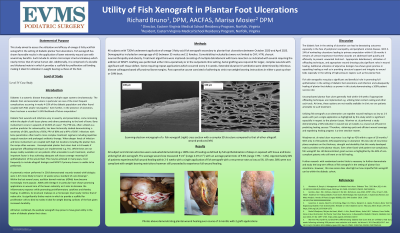Case Series/Study
(CS-031) Utility of Fish Xenograft in Diabetic Plantar Foot Ulcerations

Methods:
A case series of 46 subjects with type II diabetes who underwent application of fish xenograft in the setting of plantar foot ulcerations between October 2020 and April 2023. Comorbidities included but were not limited to CHF, HTN, charcot neuroarthropathy and obesity. All patients underwent appropriate surgical resection of infected bone and/or soft tissue with serial debridements and/or negative pressure vacuum therapy and antibiotics. Single or serial grafting was performed as indicated.
Results:
All subjects and clinical outcomes were evaluated demonstrating a 100% rate of healing as defined by full epithelialization of deep or exposed soft tissue and bone with only a 5% rate of re-ulceration. Grafts were, on average, reapplied twice with full time of healing achieved at approximately 18 weeks. 32% of patients experienced full healing within 2-3 weeks after a single application. Of note, 38% of patients were not compliant with weight bearing restrictions but still continued on to experience full healing.
Discussion:
These results bring attention to fish xenografts in its utility and efficacy of healing diabetic plantar foot ulcerations when coupled with appropriate surgical resection and medical management. Plantar foot ulcerations pose a unique challenge to treat given the impacts of weight bearing in delaying healing time. With only 2 of 46 patients (5%) experiencing re-ulceration, not only are these xenografts effective in remodeling tissue but are also extremely durable, adding strength to plantar tissues even in the setting of non-compliance. As such, fish xenograft demonstrates significant utility in the healing of plantar foot ulcerations within the diabetic cohort.
Trademarked Items:
References:

.png)